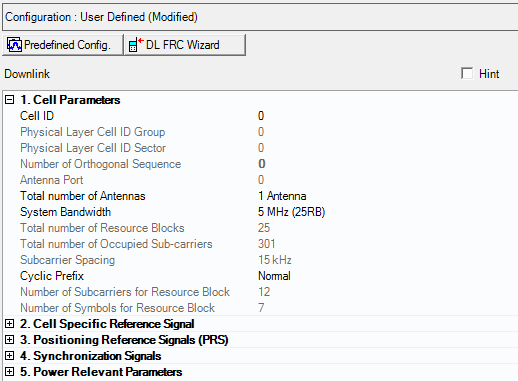
Additional Downlink parameters are described in Cell Specific Reference Signal (Advanced LTE FDD Downlink), Positioning Reference Signals (PRS) - (Advanced LTE FDD Downlink), Synchronization Signals (Advanced LTE FDD Downlink), and Power Relevant Parameters (Advanced LTE FDD Downlink).

|
1. Cell Parameters |
|---|
Range: 0 to 503
Default: 1
Enter a value for the Cell ID. The software sets the values in the and cells based on the entry. Cell ID = [(3 x Physical Cell ID Group) + Physical Cell ID Sector]. See 3GPP TS 36.211.
Range: 0 to 167
Default: 0
The software sets this value based on the entry. Cell ID = [(3 x Physical Cell ID Group) + Physical Cell ID Sector]. (See 3GPP TS 36.211.)
Choice: 0 | 1 | 2
Default: 0
The software sets this value based on the entry. Cell ID = [(3 x Physical Cell ID Group) + Physical Cell ID Sector]. (See 3GPP TS 36.211.)
Range: 0 to 2
When you set the value in the Physical Layer Cell ID Sector cell, the software sets the Number of Orthogonal Sequence to the corresponding value. (See 3GPP TS 36.211.)
Choice: 0 | 1 | 2 | 3
Default: 0
In multi-antenna configurations, specify the antenna to be used for transmitting the downlink signal. The available selections are determined by the setting.
Choice: 1 Antenna | 2 Antennas | 4 Antennas
Default: 1 Antenna
Specify the total number of base station antennas.
For multiple signal generator configurations, set the Channel State parameter in the Fading section of the Carrier node to to make this cell active. When the channel state is off, you must change the number of signal generators (for example, use a Quick Setup) to change the number of BS antennas.
Choice: 1.4 MHz (6RB) | 3 MHz (15RB) | 5 MHz (25RB) | 10 MHz (50RB) | 15 MHz (75RB) | 20 MHz (100RB)
Default: 5 MHz (25RB)
Double-click or use the drop-down menu to set the system bandwidth and number of Resource Blocks (RB).
The value in this cell is set by the software based on the setting.
The value in this cell is set by the software based on the setting. The center subcarrier is not used for downlink transmission, so the number of transmitted subcarriers is one less than the number of occupied subcarriers.
Default: 15 kHz
Displays the subcarrier spacing for the downlink. Only 15 kHz spacing is available in this release.
Choice: Normal | Extended
Default: Normal
Double-click or use the drop-down menu to select a or cyclic prefix. The software sets the based on the cyclic prefix selection.
Default: 12
Displays the number of consecutive subcarriers in a downlink resource block.
Default: 7 for Cyclic Prefix; 6 for Cyclic Prefix
Displays the number of consecutive OFDM symbols in a downlink slot.